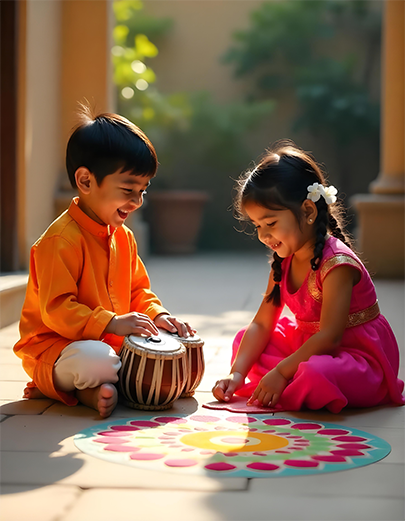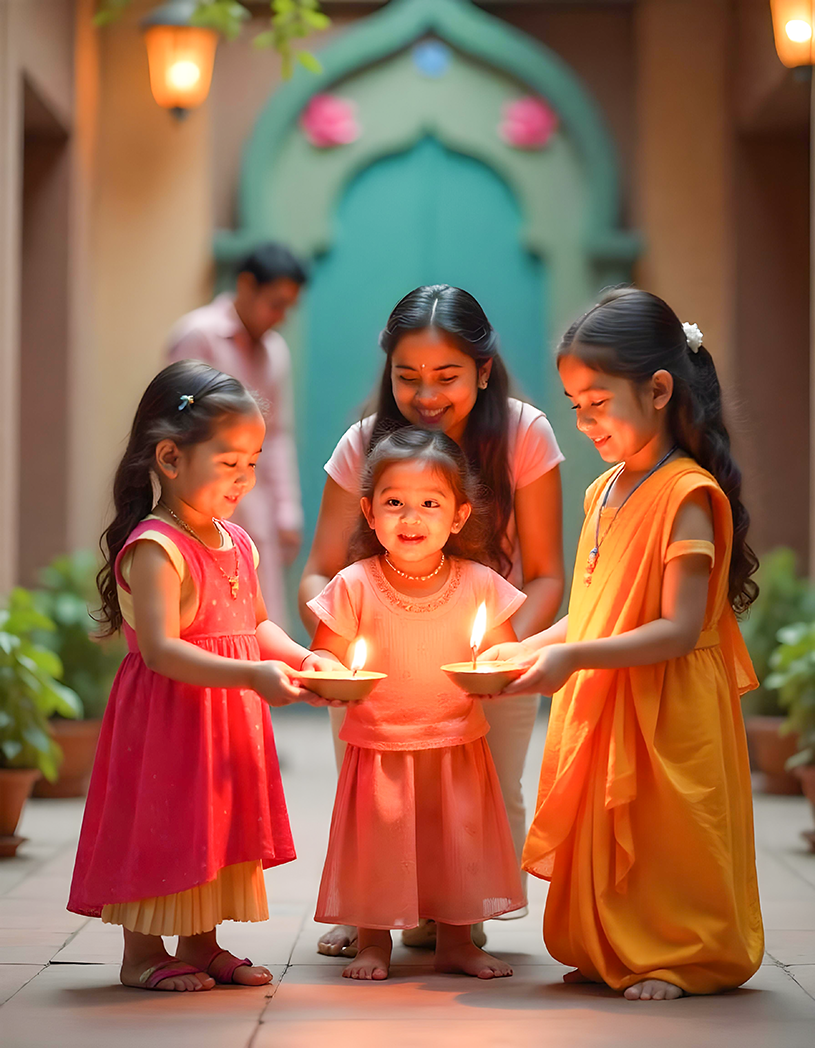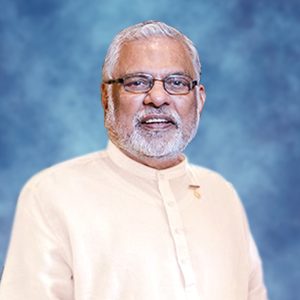Hindu Parenting in the USA: Raising Dharmic Children in a Modern World
By Raj Shah

Raising children is among the most noble and fulfilling responsibilities. For Hindu parents in the United States, the journey is uniquely meaningful. Living amidst the dynamics of American life while carrying forward the ancient spiritual legacy of Sanatana Dharma requires a conscious, creative approach—one that goes beyond rituals and textbooks to offer children a joyful, lived experience of dharma.
Let us explore the philosophy, practices, and challenges of Hindu parenting in America—celebrating how families are nurturing spiritually rooted, culturally aware, and morally grounded children.
Living Dharma: Parents as Role Models
Hindu parenting centers around dharma—righteous living guided by spiritual values like ahimsa (non-violence), satya (truth), karuna (compassion), and shraddha (reverence). These values are not taught through lectures but absorbed through observation.
Children imitate what they see more than what they’re told. “When parents consistently live their values—showing kindness, respecting elders, praying with devotion—children naturally internalize them.”
In the American context, where individualism and self-expression often dominate, Hindu parents strive to instill humility, gratitude, and devotion. Bedtime stories from epics like the Mahabharata or Ramayana, and sharing personal examples, are effective ways to make values relatable.
Joyful Engagement with Dharma
A common mistake in value-based parenting is reducing teachings to abstract rules. Hinduism offers rasa—emotional richness—as an antidote. Through festivals, stories, rituals, and arts, dharma becomes something children feel, not just learn.
Let children experience the joy of lighting diyas at Diwali, hear the conch shell during puja, or dress up for Navratri. Introduce Arjuna’s internal conflict instead of merely quoting the Gita. Let Nachiketa’s questions ignite curiosity. These emotional imprints create deep, lasting connections.
Adapting to Today’s World
 While Sanatana Dharma is eternal, parenting must evolve with the times. Children today face influences from media, school, and peers that may undermine or misrepresent Hindu values. Rather than shielding them, Hindu parenting invites critical thinking. Encourage children to ask questions. A parent who says, “Let’s find out together,” becomes a guide rather than an authority figure.
While Sanatana Dharma is eternal, parenting must evolve with the times. Children today face influences from media, school, and peers that may undermine or misrepresent Hindu values. Rather than shielding them, Hindu parenting invites critical thinking. Encourage children to ask questions. A parent who says, “Let’s find out together,” becomes a guide rather than an authority figure.
We must also help children understand not just our tradition but how to assess what they see in popular culture. Teach discernment. Equip them to evaluate, not just consume.
Making Children Stakeholders
Children won’t care about their culture unless they see us living it joyfully. Rather than enforcing practices, ask what part of the tradition excites them. Maybe it’s Bharatanatyam, cooking festive meals, painting kolams, or playing tabla.
When children take pride in even one aspect of their heritage, it plants a seed of belonging. Over time, this seed grows into ownership—transforming cultural curiosity into committed identity.
Festivals as Cultural Anchors
Hinduism’s vibrant festivals offer a natural platform for value transmission. Diwali, Holi, Navratri, and Raksha Bandhan are full of color, music, and meaning. In the U.S., where these are not public holidays, parents play a vital role in organizing community celebrations.
Children absorb lessons in dharma through these joyful events—learning about the triumph of light over darkness, devotion, duty, and sacrifice. The rituals—rangoli making, tying rakhi, lighting lamps—become cherished memories tied to identity.
A Personal Commitment to Teaching Dharma
For my wife Aruna and me, teaching Hindu values to young children has been a deeply personal mission. Over the past ten years, we have made it a tradition to host an annual Diwali puja at our home, designed especially for children. What makes this event unique is that the children—not the adults—perform the full puja themselves. They light the diyas, chant the mantras, offer flowers, and lead the aarti, while the parents sit quietly behind them, observing with pride and reverence.
What began modestly with just 2 or 3 families has now grown into a cherished community event involving nearly 25 families. The excitement and joy it brings to the children is truly heartwarming. Each year, the puja concludes with a question-and-answer session about Hinduism, where children eagerly share what they’ve learned and ask meaningful questions about our traditions and scriptures.
What touches us most is the enthusiasm these young participants carry beyond our home. They look forward to this Diwali puja all year long, talk about it with their friends, and—on their own initiative—invite their friends and their parents to join. This celebration has become more than just a ritual; it’s a living expression of dharma, community, and joy—led by the very children we hope to inspire.
 Temples and Community Support
Temples and Community Support
Temples in the U.S. are more than places of worship. They serve as cultural and spiritual centers offering Sunday schools, Bal Vihar, and community events. Children learn shlokas, perform skits, and engage with peers who share their background—offering a safe space for spiritual growth.
Temples provide a place where children don’t need to explain their customs or feel “different.” They find others who fast on Janmashtami or sing bhajans with familiarity. This sense of belonging strengthens pride in their identity.
Bal Vihar: Learning with Joy and Community
Bal Vihar classes, offered by organizations like Chinmaya Mission and HSS, go beyond instruction. They bring dharma to life through stories, music, yoga, art, and discussion. Children explore values like seva (service), karma (action), and satya (truth) in ways that resonate.
Equally important is the community they build. Friendships formed in these classes become support systems through adolescence and beyond. These bonds give children a sense of cultural normalcy—and joy—in an otherwise different environment.
Education as a Sacred Path
In Hinduism, education is sacred. Goddess Saraswati is invoked before learning, and knowledge is seen as both intellectual and spiritual. Parents often support both academic excellence and enrichment in classical arts like Carnatic music, Bharatanatyam, or Sanskrit chanting.
There is also a growing encouragement to explore humanities fields like law, philosophy, and journalism—empowering children to articulate Hindu values in public forums and correct misrepresentations with clarity and confidence.
Storytelling and the Power of Epics
The Ramayana, Mahabharata, and Bhagavad Gita are rich with moral wisdom. Stories of Krishna’s guidance to Arjuna, Hanuman’s loyalty, and Sita’s strength offer insights into courage, duty, and compassion.
Instead of focusing on rote memorization, use stories to explore dilemmas children face—peer pressure, emotional conflict, or choices. Let the scriptures speak through narrative and reflection, not just repetition.
 Language, Mantras, and Identity
Language, Mantras, and Identity
Even a few spiritual words—like “Namaste” or “Jai Shri Krishna”—can build a deep cultural connection. Parents often teach key prayers like the Gayatri Mantra or Hanuman Chalisa, helping children link language with spiritual identity.
Understanding the meaning behind prayers turns recitation into reflection. It also offers a way to calm the mind, invoke inner strength, and feel rooted during moments of stress or confusion.
Embracing Technology Mindfully
Technology is often blamed for distraction, but it can be a bridge too. Curated content—animated Hindu stories, Gita podcasts, or interactive Sanskrit apps—can support dharmic learning. Live-streamed aartis and online classes keep traditions accessible.
Video calls with grandparents in India or watching bhajans together can create emotional connections. The key is mindful use—curating content and participating together, rather than handing over devices passively.
Building Bicultural Identity
One of the most delicate tasks Hindu parents face is helping children navigate bicultural identity. American culture values autonomy and freedom, while Hindu tradition emphasizes family, responsibility, and self-restraint.
Children may struggle with issues around dating, marriage, fasting, or faith. Instead of enforcing rules, parents must explain values, model them with love, and stay open to questions. Successful parenting balances freedom with cultural grounding.
Rediscovering Hindu Wisdom
Ironically, as Western parenting trends embrace rituals, mindfulness, and emotional well-being, many Hindu parents look West for guidance. But Hinduism already offers these treasures—daily rituals, community, meditation, and emotional regulation.
We must rediscover and reclaim our heritage—not out of fear, but with pride and joy. From singing bhajans to celebrating Diwali with friends, from temple volunteering to philosophical inquiry, our tradition offers everything children need to grow into joyful, balanced adults.
Joyful Connection Over Cultural Obligation
 “Children will not love their culture because we insist—they’ll love it because it brings them joy.” Whether through Garba dancing, Kolam painting, or preparing festive foods, emotional bonding comes first. Even one joyful experience can ignite lifelong interest.
“Children will not love their culture because we insist—they’ll love it because it brings them joy.” Whether through Garba dancing, Kolam painting, or preparing festive foods, emotional bonding comes first. Even one joyful experience can ignite lifelong interest.
A child who loves Krishna through music or Durga through painting begins to take pride in their faith. Over time, joy matures into responsibility—and eventually, leadership.
The Role of Grandparents and Visits to India
Grandparents—Dada-Dadi and Nana-Nani—bring stories, traditions, and gentle wisdom that deepen the family’s spiritual roots. Their role in sharing stories, leading prayers, and simply being present is invaluable.
Trips to India, visits to temples, or participation in family functions offer powerful reinforcement. They help children connect with their roots in a personal, immersive way, making Hinduism real and memorable.
Giving Children Two Wings
Hindu parenting in America is a spiritual yajna—a sacred offering of time, effort, and love. It is not about rejecting modernity but grounding children so they can face the world with clarity, compassion, and strength.
“We must give our children two wings—one rooted in dharma and the other free to soar in American skies.” As the Gita says: “Uddhared atmanātmānaṁ na atmanam avasādayet”—“Elevate yourself through your own efforts.” This is our call as parents: to nurture, inspire, and elevate the next generation to carry the light of Sanatana Dharma into the future.
Conscious Parenting: A Sacred Responsibility
Parenting on the kshurasya dhara—the razor’s edge—requires careful balance. The goal is not to impose tradition but to make it irresistible through love, joy, and intention.
Let our homes echo with sacred stories and laughter. “Let our parenting become a spiritual offering—shaped by patience, humility, and grace.” In doing so, we won’t just raise good children—we’ll raise torchbearers of Sanatana Dharma.
About the Author:
 A software engineer by profession, Indian culture enthusiast, ardent promoter of hinduism, and a cancer survivor, Raj Shah is a managing editor of Desh-Videsh Magazine and co-founder of Desh Videsh Media Group. Promoting the rich culture and heritage of India and Hinduism has been his motto ever since he arrived in the US in 1969.
A software engineer by profession, Indian culture enthusiast, ardent promoter of hinduism, and a cancer survivor, Raj Shah is a managing editor of Desh-Videsh Magazine and co-founder of Desh Videsh Media Group. Promoting the rich culture and heritage of India and Hinduism has been his motto ever since he arrived in the US in 1969.
He has been instrumental in starting and promoting several community organizations such as the Indian Religious and Cultural Center and International Hindu University. Raj has written two books on Hinduism titled Chronology of Hinduism and Understanding Hinduism. He has also written several children books focusing on Hindu culture and religion.

In one of the powerful discourses by Sadhguru about parenting, he challenges conventional ideas of parenting, emphasizing that children “come through you, not from you.” They are not your property or legacy to mold as you wish. Treating them as such is, in his words, a “sacrilege against Creation and the Creator.” True parenting, he argues, is not about controlling or owning a child but about liberating them and respecting their individual journey. Sadhguru calls out the hypocrisy in many parents who preach detachment according to scriptures like the Bhagavad Gita yet expect their children to be emotionally dependent on them. Instead of being a boss in the home, he suggests being a companion: “What they need is a friend, not a bloody father and mother.” He cautions against brainwashing children into blind obedience, which only provokes rebellion. Rather, nurture their independent intelligence so they come to you not out of compulsion but out of trust. “If you bring up your child with a fierce sense of his intelligence… he will seek help because he’ll realize his understanding is not enough for everything.” Ultimately, the responsibility lies in self-transformation. “If you want to raise children, please raise yourself,” Sadhguru advises. Children don’t follow what you say—they mirror what you do. Respect the sacred privilege of being a parent by living with authenticity, sincerity, and involvement. Parenting, he concludes, is not about raising someone to meet your expectations—but about becoming someone worth imitating. |
 Bk Sister Shivani ji, in one of her lectures, explores the profound parenting mantra: “Don’t raise your kids to have more than you had—raise them to be more than you were.” Sister Shivani explains that modern parenting often focuses on providing children with material comforts—first-class travel, air-conditioned homes, and digital gadgets—but neglects inner strength and emotional resilience. Drawing from ancient wisdom and personal stories, she emphasizes how royal children were once sent to Gurukuls to live simply, do physical chores, and grow spiritually—preparing them to rule not just kingdoms but their minds. Today, overindulgence and dependence on comforts make children emotionally weak, vulnerable to stress, and socially disconnected. Parents should prioritize spiritual and emotional strength over material success. Children must learn to adapt to different environments, interact with diverse people, and live without dependency on gadgets or luxury. Practices build inner power, like eating without screens, participating in household chores, and balancing comfort with discipline. Ultimately, true parenting is not about convenience or indulgence but about building strong, independent, and value-rooted souls. As Sister Shivani concludes, we must nurture our children for complete well-being—strong souls, healthy bodies, and harmonious relationships. |































